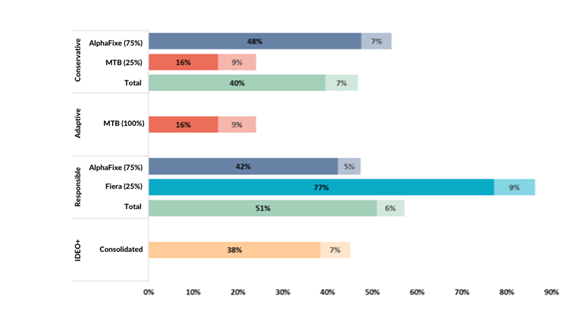Sustainable investment at Kaleido
Since 1964, Kaleido has focused on education savings to ensure a bright future for our youth and help build tomorrow’s society. Kaleido operates with an eye to the future and believes it is important to invest in sustainable businesses and projects that create long-term value in society.

What is sustainable investment?
Sustainable investing means using our investments to make an active commitment to the protection of the environment, the welfare of individuals, and better management of the funds entrusted to us.
In other words, it means choosing to invest with an eye not only to economic factors but also to broader criteria that have an impact on our environment and our societies. Sustainable investing is also known by other names, such as "responsible investing," "ethical investing" or "impact investing."
How does Kaleido integrate responsible investment policies?
All Kaleido’s assets are entrusted to managers who are signatories to the Principles for Responsible Investment (PRI), an investor initiative supported by the United Nations.
All the managers we work with have made a commitment under the PRI to consider ESG factors in their investment processes and to report annually on their ESG activities.
What are ESG factors?

Environment
ENVIRONMENTAL factors have to do with a company’s behaviour with respect to environmental protection and conservation. Reduction of greenhouse gasses (GHG), water management, waste management policies, protection of biodiversity, clean energy use and reduction of waste are examples of practices that meet environmental criteria.

Social
SOCIAL factors deal with a company’s social responsibility and the way it manages relationships with its employees, suppliers, customers, and other stakeholders such as the communities in which it operates. Ensuring the well-being of employees, not negatively impacting communities, maintaining suitable working conditions, positive relations with the community, customers, and suppliers, non-exploitation of children as well as respect and gender equity in the workplace are examples of practices that meet the social criteria.

Governance
GOVERNANCE factors have to do with a company’s decisionmaking bodies (board of directors, senior management), executive compensation, and internal controls. Anti-corruption measures, cybersecurity measures, salary cap for management and lobbying management are examples of practices that meet the governance criteria.
Proactive portfolio managers
It is crucial to us that all managers we do bu siness with be firmly committed to sustainable investment and apply best practices in this area. In addition to following the UN Principles for Responsible Investment (PRI), our managers provide better management of investment risks and opportunities for our clients while contributing to a sustainable future for our children.
 What's more, at the 2022 Great Canadian ESG Championship, an event designed to highlight the responsible investment choices available to Canadians, two of our portfolio managers stood out from the crowd. AlphaFixe Capital won the fixed-income category, while Jarislowsky Fraser won the multi-asset category.
What's more, at the 2022 Great Canadian ESG Championship, an event designed to highlight the responsible investment choices available to Canadians, two of our portfolio managers stood out from the crowd. AlphaFixe Capital won the fixed-income category, while Jarislowsky Fraser won the multi-asset category.
Is sustainable investment profitable?
Responsible investing doesn't mean sacrificing performance or returns - on the contrary! Based on what we know so far, responsible investing can generate a return that is equal to or even better than other traditional investments.4
RESPs that go beyond our Sustainable Investment Policy
Our line of IDEO+ individual registered education savings plans includes three scholarship plans designed to meet families' needs and preferences for responsible investing. All IDEO+ individual RESPs are invested in accordance with our Sustainable Investing Policy. Among them, the IDEO+ Responsible plan stands out by going beyond our Sustainable Investment Policy.
The plan incorporates impact investing principles aimed at generating more positive environmental and social impacts on two themes related to sustainable development: climate change and children's welfare and education. This enables parents to invest in a sustainable future for their children.
A look at some figures illustrating our commitment to responsible investment
All data are as at December 31, 2023.
What is carbon intensity?
This is the quantity of greenhouse gas emissions generated by a company and, by extension, by all the companies in an investment portfolio. A portfolio's carbon intensity is calculated by dividing the companies' CO2 emissions by their sales. It can be used to measure an entity's carbon footprint, making it a key indicator for assessing the environmental sustainability of a fund or investment.
What do we mean by "green bonds" and "sustainable bonds"?
Green bonds are debt securities issued to finance ecologically sustainable projects that have a positive impact on the environment (e.g. initiatives to reduce greenhouse gas emissions or promote renewable energy).
Sustainable bonds, on the other hand, are linked to projects targeting positive environmental and social benefits.

Green bonds and carbon intensity: impact on our RESPs
The chart below illustrates the proportion of green bonds and sustainable bonds in the various plans of our IDEO+ RESP line. As of September 30, 2023, for all three IDEO+ plans, 38% of bonds in the portfolio are "green" bonds, and 7% are sustainable bonds.
To learn more about Kaleido’s commitment to sustainable investment:
Consult our sustainable investment policy
Consult our 2023 sustainable investment report

Want to learn more about responsible investing?
Download our free e-book about it!

1. Growth based on value in Canadian dollars of assets invested in green bonds.
2. Carbon intensity measures a portfolio’s exposure to companies with high carbon emissions intensity. It is expressed in tonnes of CO2 emissions per million US dollars of revenue. It is the metric recommended by the Task Force on Climate-Related Financial Disclosures (TCFD).
3. Average unweighted carbon intensity based on data provided by each portfolio manager.
4. For more details, visit the Sustainable Investment Association website at www.riacanada.ca/.